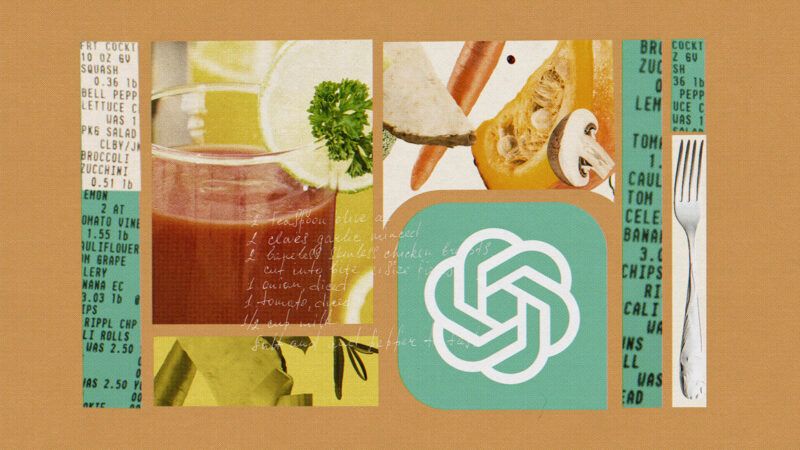ChatGPT Planned My Dinner and I Have No Complaints
A.I. won’t kill cooking. Instead, it’ll help people become more creative and efficient in the kitchen.

In between the many predictions of professional displacement and civilizational doom at the hands of artificial intelligence (A.I.) tools like ChatGPT, people are discovering some genuinely useful ways to incorporate them into the more mundane parts of life. They're adept at improving emails, recommending new bands, and helping with homework.
Folks are putting ChatGPT to work in the kitchen, too, to great effect. In a recent Twitter thread, a Silicon Valley CEO described his "surprisingly delightful" ChatGPT-powered dinner party where the A.I. program suggested fusion themes and generated a menu, serving sizes, and cooking instructions. As someone who spends far too much time digging online for recipes, I decided to see whether ChatGPT could make me more efficient in the kitchen.
I started by asking for cuisine suggestions, which ChatGPT spat out with minimal prodding. After it gave me a laundry list of options, explaining why certain flavors and ingredients would pair well, I decided on a Moroccan-inspired menu consisting of an entree, a vegetable side, and a cocktail. Not every option was a winner, and plenty of the recipes I got during the discovery process featured errors only a robot would make—for instance, a Mediterranean-style chicken and chorizo stew that featured just one cup of broth, and an ostensibly Moroccan-themed mule that simply repeated the ingredients of a Moscow mule.
Still, it took some 15 minutes to receive dozens of recipe suggestions tailored to my cuisine and flavor preferences, with steps and ingredients fully spelled out such that I could pick the dishes best suited to my on-hand ingredients and available time. I settled on three promising options: Moroccan chicken skewers with spiced yogurt sauce, Moroccan-spiced roasted carrots, and a Marrakech mule.
Barring a few personal tweaks—adding more paprika and introducing honey to the yogurt sauce, adding olive oil to the (otherwise dry) chicken marinade, baking the skewers instead of grilling them—I was impressed with ChatGPT's output. The mule, a combination of lime, orange, honey, and ginger, was a real treat. The chicken and carrots were a bit redundant, with ChatGPT proposing essentially the same seasonings for both—but they were flavorful nonetheless. As an experiment in reducing my planning time while maintaining or improving recipe quality, I have no complaints.
Kitchen-helper A.I. has been in the works for a while now. In 2014, Bon Appétit's test kitchen teamed up with IBM's Chef Watson, a recipe-creating computer program, to invent new dishes. Working with an information bank of 10,000 Bon Appétit recipes, Watson could "understand and reproduce their underlying logic and style" to propose novel ones, many involving unique ingredient pairings that don't go together intuitively, but instead work "on a fundamental chemical level."
Promising, but it wasn't all smooth sailing. Testing the program in 2016, The Guardian's Leo Benedictus noted that "Chef Watson recommends an ingredient called 'Mollusk', which it helpfully explains is 'the sixth full-length album by Ween.'" Watson's performance in a cooking challenge against chef Yotam Ottolenghi yielded "a flavour rather close to the farmyard, but not uneatable." (Of course, Ottolenghi and his team had the advantage of being able to "taste and discuss flavours, colours, temperatures, in a way that Watson can't.") Florian Pinel, Chef Watson's lead engineer, told Benedictus that a feedback mechanism could be on its way in the future.
ChatGPT is highly adept in that way. When I told it that I don't have a grill, it suggested I saute. When I rejected its seafood recipes, it switched to chicken options. When I mentioned that I didn't have the mint or cilantro the spiced yogurt recipe called for, it suggested I substitute coriander or parsley to compensate for the missing flavor. (To the robot's credit, both fit the Moroccan theme.)
Still, A.I.-generated recipes haven't escaped criticism. Some of that centers on cultural appropriation concerns: A Food and Wine ChatGPT experiment prompted the author to worry that a Korean BBQ nacho recipe "did not accurately represent the complexity of Korean cuisine, and it felt like a superficial appropriation of cultural recipes" that lacked "contextual understanding of what truly constitutes Korean BBQ." Tash McGill, president of Food Writers New Zealand, warned that these recipes "can easily stray into issues with cultural appropriation or untested techniques." A 2014 Slate article fretted over the intellectual property implications of A.I. recipes, also wondering who might be held liable if an A.I.-driven commercial kitchen caused an allergic reaction.
Intellectual property issues will be ironed out in time, and A.I.-induced allergic reactions are unlikely to be problematic in private kitchens. As for cultural appropriation concerns, those misunderstand one of ChatGPT's biggest advantages as a cooking tool: its ability to creatively incorporate snippets of a culture's cuisine to varying degrees and in ways that consider the user's culinary preferences and background. You can start with a format you love—salads or soups, for example—and ask ChatGPT to use it as a canvas for an unfamiliar cuisine. Or you can start with a cuisine you love and ask ChatGPT to marry it to a new one. From Mediterranean-Mexican to Japanese-Italian, the resulting recipes sound surprisingly delicious, even if they'd make culinary purists blush.
As a kitchen assistant, ChatGPT is most helpful when its efforts are combined with human ones—vetting for errors, adjusting seasonings to taste, and making ingredient or equipment limitations known. A.I. won't destroy cooking, but it has huge potential to make chefs more creative and efficient.



Show Comments (118)